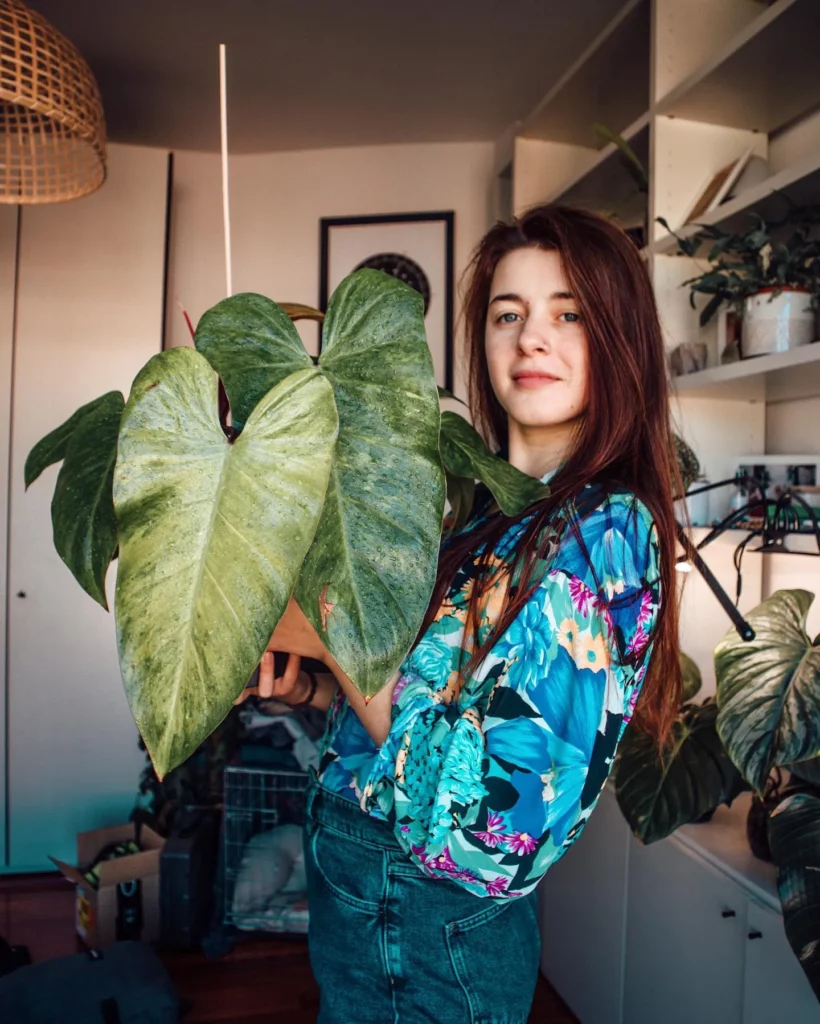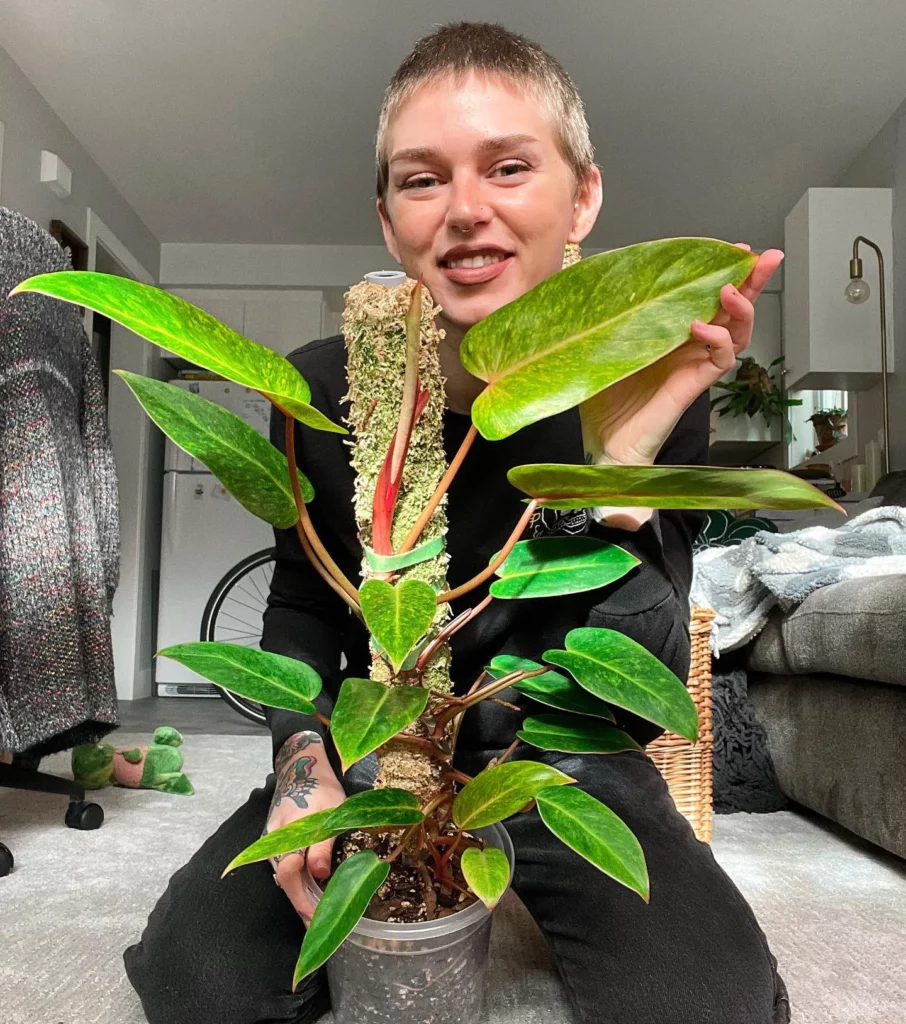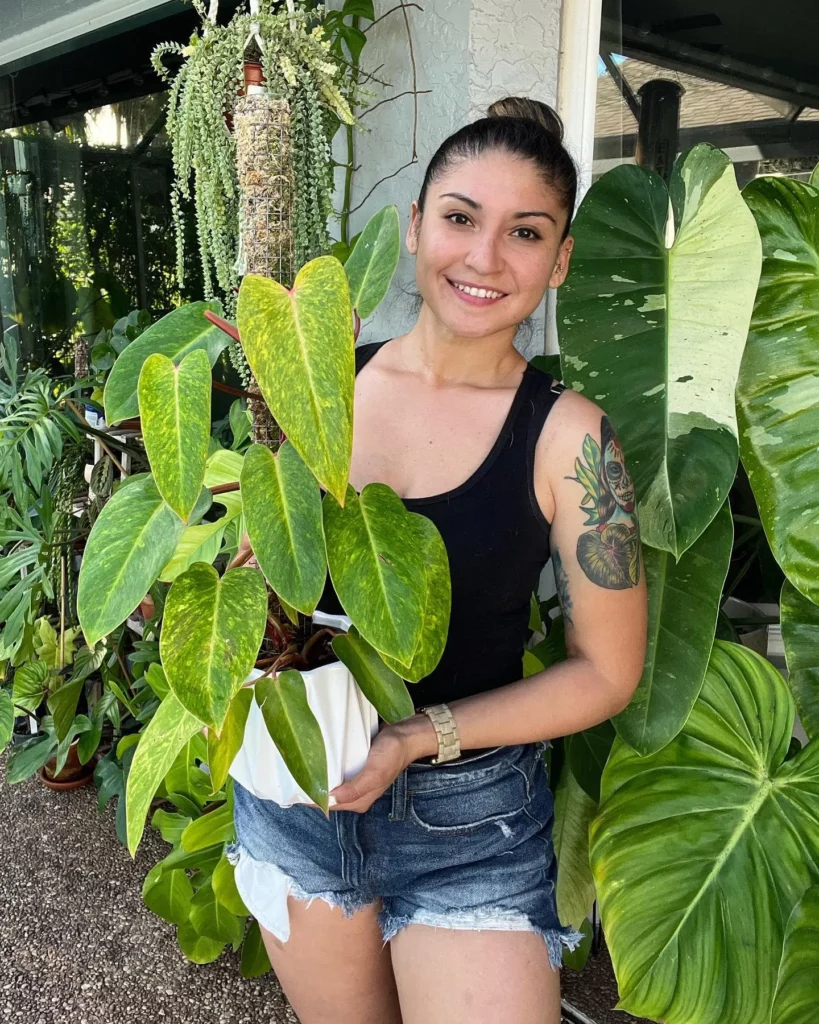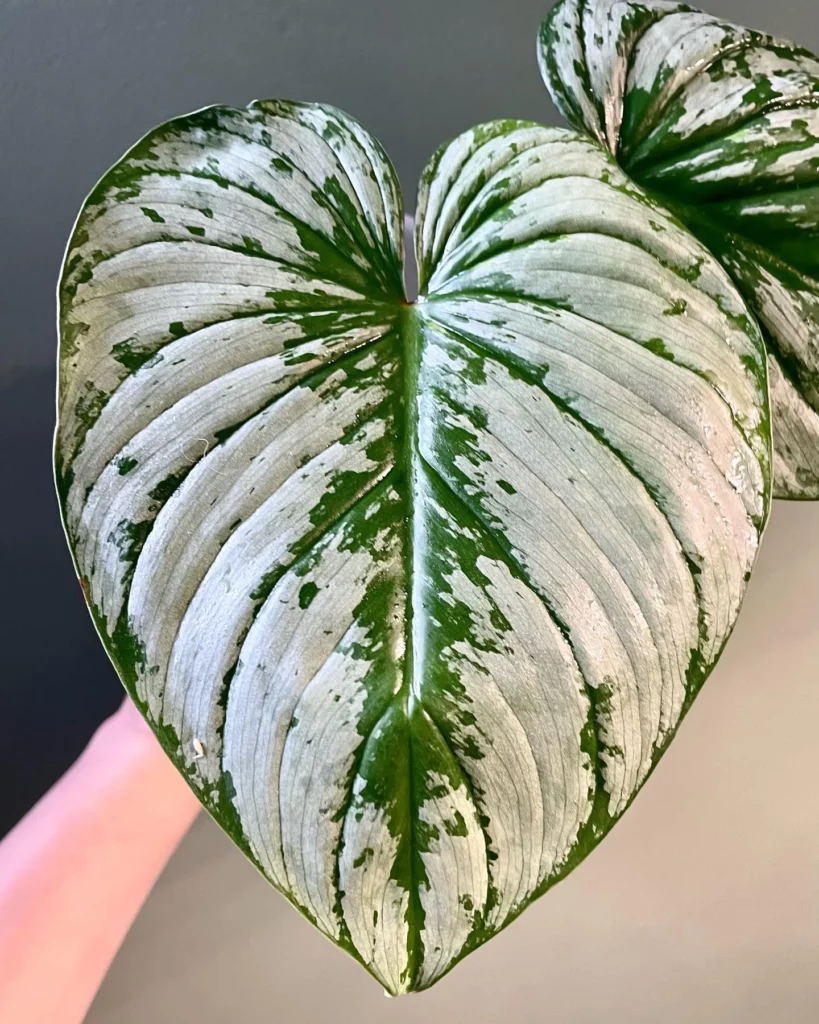The Philodendron Painted Lady is a visually stunning plant with its unique appearance. Its large, heart-shaped leaves are variegated with vibrant shades of green and yellow, creating an eye-catching display. The petioles, or leaf stalks, add an additional pop of color with their pink and red hues. The glossy foliage has a waxy texture, adding to its overall beauty.
Key Takeaways:
- Philodendron Painted Lady is a stunning P. erubescens hybrid with variegated leaves and vibrant hues.
- It thrives in bright, indirect light and prefers slightly moist soil.
Appearance of Philodendron Painted Lady



The leaves of the Philodendron Painted Lady can grow up to 2 feet long, making it a truly impressive plant. The size of its foliage contributes to its striking presence, whether it is placed on a tabletop or displayed on the floor. Its lush and vibrant appearance is sure to brighten up any room and become a focal point of your home decor.
Gorgeous Variegation and Climbing Growth
- The large leaves of the Philodendron Painted Lady are variegated with green and yellow shades.
- The petioles, or leaf stalks, add pops of pink and red to the plant’s appearance.
- The glossy foliage has a waxy texture, enhancing its visual appeal.
- The leaves can grow up to 2 feet long, making it a visually impressive plant.
Light Requirements for Philodendron Painted Lady



Proper lighting is essential for the health and growth of the Philodendron Painted Lady. This plant thrives in bright, indirect light, which mimics its natural habitat in the understory of tropical forests. Place your Philodendron Painted Lady near a north or east-facing window where it can receive bright, filtered light throughout the day.
Avoid exposing the plant to direct sunlight for extended periods, as this can lead to leaf burn. If you don’t have access to sufficient natural light, you can supplement with artificial grow lights. LED grow lights with a spectrum similar to natural sunlight are a great option to ensure your Philodendron Painted Lady receives the right amount of light.
Key Points:
- Place Philodendron Painted Lady in bright, indirect light.
- Avoid direct sunlight to prevent leaf burn.
- Supplement with artificial grow lights if needed.
- Lower light conditions can result in slower growth and faded variegation.
Watering Philodendron Painted Lady



Proper watering is crucial for the health and vitality of your Philodendron Painted Lady. Here are some important guidelines to follow:
1. Watering Frequency
Allow the top layer of soil to dry before watering your Philodendron Painted Lady. Overwatering can lead to root rot, so it’s important to strike a balance. In general, watering once a week is sufficient, but be sure to adjust based on the plant’s needs and the environmental conditions. During colder months or periods of slower growth, reduce watering to prevent waterlogged soil.
2. Watering Technique
When watering your Philodendron Painted Lady, aim to thoroughly saturate the soil until water drains out of the bottom of the pot. This helps ensure that the entire root system is hydrated properly. Avoid overhead watering, as it can lead to fungal diseases. Instead, water directly at the base of the plant to prevent water from collecting on the leaves.
3. Check for Moisture
Regularly check the moisture level of the soil by sticking your finger about an inch deep into the soil. If it feels dry at this depth, it’s time to water. However, if it still feels slightly moist, wait a few more days before watering. Philodendron Painted Lady prefers slightly moist soil, but it’s important to avoid both underwatering and overwatering.
Fertilizing Philodendron Painted Lady
Proper fertilization is essential for the health and vibrancy of your Philodendron Painted Lady. Here are some key points to keep in mind when it comes to fertilizing this beautiful plant:
-
Choose a balanced liquid fertilizer: When selecting a fertilizer for your Philodendron Painted Lady, opt for a balanced liquid fertilizer with equal amounts of nitrogen, phosphorus, and potassium. This will provide the plant with the necessary nutrients for healthy growth.
-
Fertilize during the growing season: The Philodendron Painted Lady benefits from regular fertilization during its active growth period, which is typically in the spring and summer months. This is when the plant is actively producing new foliage and needs the extra nutrients.
-
Follow the manufacturer’s instructions: Always read and follow the instructions provided by the fertilizer manufacturer. Each product may have specific guidelines for the appropriate application rate and frequency.
-
Stop fertilizing in the fall: As the temperatures drop and the plant’s growth slows down in the fall, it’s important to stop fertilizing. This allows the plant to enter a period of dormancy and prepares it for the winter months.
-
Monitor the plant’s response: Pay attention to how your Philodendron Painted Lady responds to fertilization. If you notice any signs of overfertilization, such as burned leaf tips or stunted growth, reduce the frequency or dilute the fertilizer to avoid damaging the plant.
Potting Philodendron Painted Lady
When it comes to potting your Philodendron Painted Lady, it’s important to choose the right soil mix and pot size. A rich, well-draining soil mix is ideal for this plant’s health and growth. I recommend a combination of indoor potting soil, perlite, and orchid bark. This mix provides the right balance of nutrients and moisture retention.
When repotting, choose a pot that is only slightly larger than the previous one. This prevents overpotting and ensures that the roots have enough space to grow. Philodendron Painted Lady does not like to be confined in a tight pot, so a slightly larger pot allows for healthy root development.
Steps for Potting Philodendron Painted Lady:
- Select a pot with drainage holes to prevent waterlogging.
- Prepare the soil mix by combining indoor potting soil, perlite, and orchid bark.
- Carefully remove the plant from its current pot, taking care not to damage the roots.
- Place a layer of the soil mix at the bottom of the new pot.
- Position the plant in the pot, making sure it is centered.
- Fill the remaining space with the soil mix, gently pressing it down around the roots.
- Water the plant thoroughly to settle the soil.
Propagation of Philodendron Painted Lady
If you’re looking to expand your collection of Philodendron Painted Lady plants or share its vibrant beauty with others, propagation is a great way to do it. This stunning plant can be propagated through stem cuttings or air layering.
Taking Stem Cuttings
To propagate Philodendron Painted Lady through stem cuttings, start by selecting a healthy stem with at least three to five nodes. Nodes are the points where leaves or branches emerge from the stem. Use clean, sharp pruning shears to make a clean cut just below a node.
After removing the bottom leaves, place the cutting in a glass of water or moist soil. Keep the cutting in a warm and well-lit environment, but avoid exposing it to direct sunlight. Within a few weeks, roots should develop from the nodes. Once the roots are about an inch long, carefully transfer the cutting to a pot with well-draining soil.
Air Layering
Air layering is another effective method of propagating Philodendron Painted Lady. To air layer, make a small cut into a healthy stem just below a node. Gently remove the bark and apply rooting hormone to the exposed area. Wrap the moistened moss around the cut section and secure it with plastic wrap or a zip tie.
Keep the moss moist by misting it regularly. After a few weeks, roots should start to develop within the moss. Once the roots are well-established, carefully remove the moss and cut below the root system. Plant the rooted stem in a pot filled with well-draining soil and provide it with the proper care.
Growth and Development of Philodendron Painted Lady
Philodendron Painted Lady is a visually striking plant with its variegated large green and yellow leaves, pink and red petioles, and climbing growth habit. This beautiful plant has a slow to moderate growth rate, reaching a height of up to 5 feet and a width of up to 3 feet indoors. As the plant matures, it benefits from staking or the support of a moss pole or trellis, which not only provides support but also encourages larger leaves and a more lush appearance.
Proper care is essential for the growth and development of Philodendron Painted Lady. It requires bright, indirect light to thrive, although it can tolerate lower light conditions. Avoid direct sunlight for extended periods to prevent leaf burn. The plant prefers slightly moist soil, so allow the top layer of soil to dry before watering thoroughly. Fertilize regularly during the growing season and repot every two years or when roots outgrow the pot.
With its climbing growth habit, Philodendron Painted Lady adds a touch of elegance to any space. By providing a structure for the plant to climb, you can enhance its overall beauty and create a stunning focal point in your home. Just make sure to monitor its growth and appearance, addressing any issues promptly. With proper care and attention, your Philodendron Painted Lady will continue to grow and develop, rewarding you with its vibrant beauty for years to come.
Pests and Diseases of Philodendron Painted Lady
While the Philodendron Painted Lady is generally resistant to pests and diseases, it is still important to be vigilant and take preventive measures. Here are some common pests that may affect your plant:
- Mealybugs: These small, white insects can be found on the undersides of leaves and in leaf axils. They feed on the plant sap, causing damage and stunting growth.
- Spider mites: These tiny pests are often difficult to spot, but their presence can be identified by the fine webbing they produce. They usually infest the undersides of leaves and can cause yellowing, speckling, and leaf drop.
- Scale: Scale insects are small, oval-shaped pests that attach themselves to the leaves and stems of plants. They can be brown, black, or white in color and can cause discoloration, leaf drop, and overall decline in plant health.
In addition to pests, Philodendron Painted Lady can also be susceptible to fungal leaf spot diseases. These diseases are often caused by excessive moisture or poor air circulation. Common symptoms include brown or black spots on the leaves, which can spread and cause significant damage to the plant if not treated promptly.
Climbing Growth Habit of Philodendron Painted Lady
The Philodendron Painted Lady is not only admired for its vibrant beauty but also its unique climbing growth habit. As the plant matures, it naturally begins to climb and reach for support. To enhance its growth and overall appearance, providing a structure such as a stake, moss pole, or trellis is highly beneficial.
By allowing the Philodendron Painted Lady to climb, you are encouraging larger leaves and a more lush foliage. The plant will wrap its aerial roots around the support structure, providing stability and allowing it to grow vertically. This climbing nature adds an interesting architectural element to any indoor space.
To guide the climbing growth habit of the Philodendron Painted Lady, gently train the vines and stems towards the support structure. Once they make contact, they will naturally cling and continue their ascent. Regularly check and adjust the plant’s positioning to ensure it stays within the desired boundaries.
Rareness of Philodendron Painted Lady
The Philodendron Painted Lady is considered relatively rare, adding to its allure among plant enthusiasts. While it may not be commonly found in local supermarkets or big box stores, you can usually find it at specialty houseplant shops or nurseries. This exclusivity enhances the plant’s appeal, making it a sought-after addition to any indoor plant collection.
The Philodendron Painted Lady’s rareness stems from its unique characteristics and vibrant foliage. Its large, variegated leaves, with their striking green and yellow patterns, make it a visually captivating plant. The pink and red petioles further enhance its beauty, adding a splash of color to any space.
As the demand for the Philodendron Painted Lady grows, it is becoming more readily available in the market. However, its limited availability compared to other common houseplants contributes to its reputation as a rare find. So, if you come across this stunning plant, don’t miss the opportunity to bring a touch of rare beauty into your home.
Common Problems with Philodendron Painted Lady
As a plant enthusiast, I’ve come across some common problems that can arise when caring for Philodendron Painted Lady. One issue you may encounter is yellow leaves. This can be caused by inadequate light or underwatering. Make sure your plant is getting enough indirect sunlight and adjust your watering routine if needed.
Another problem that can occur is brown leaves. This can be the result of a lack of humidity or sunlight. Ensure your plant is in a suitable environment with enough moisture in the air, and consider moving it to a spot where it can receive adequate light. Brown leaves can also be a sign of fungal leaf spot diseases. If you notice any spots on the leaves, treat them with an appropriate fungicide.
FAQ
What is the appearance of the Philodendron Painted Lady?
The Philodendron Painted Lady has large, variegated heart-shaped leaves that are green and yellow. The petioles are pink and red, adding to its striking appearance. The foliage is glossy and has a waxy texture.
What are the light requirements for the Philodendron Painted Lady?
The Philodendron Painted Lady thrives in bright, indirect light. It can tolerate lower light conditions, but growth may be slow and variegation may be lost. Avoid exposing the plant to direct sunlight for long periods as it can burn the leaves.
How should I water the Philodendron Painted Lady?
The Philodendron Painted Lady prefers slightly moist soil. Allow the top layer of soil to dry before watering thoroughly. Avoid overwatering, as this can lead to root rot. Watering once a week is usually sufficient, but adjust based on the plant’s needs and environmental conditions.
How do I fertilize the Philodendron Painted Lady?
Fertilize the Philodendron Painted Lady regularly during the growing season, typically in spring and summer. Use a balanced liquid fertilizer and follow the manufacturer’s instructions. Stop fertilizing in the fall when temperatures drop and growth slows down.
How should I pot the Philodendron Painted Lady?
The Philodendron Painted Lady does well in a rich, well-draining soil mix. A combination of indoor potting soil, perlite, and orchid bark is ideal. Repot once every two years or when roots grow out of the drainage holes. Choose a pot slightly larger than the previous one to avoid overpotting.
How can I propagate the Philodendron Painted Lady?
Philodendron Painted Lady can be propagated through stem cuttings. Take a healthy stem cutting with at least three to five nodes and remove the bottom leaves. Place the cutting in water or moist soil until roots develop, then transfer it to a pot with well-draining soil. Air layering is another method of propagation.
How does the Philodendron Painted Lady grow and develop?
Philodendron Painted Lady has a slow to moderate growth rate. It can reach a height of up to 5 feet and a width of up to 3 feet indoors. The plant benefits from staking or the support of a moss pole or trellis as it matures, encouraging larger leaves and a more lush appearance.
What pests and diseases should I watch out for with the Philodendron Painted Lady?
Philodendron Painted Lady is generally resistant to pests and diseases, but can be susceptible to common houseplant pests such as mealybugs, spider mites, and scale. Fungal leaf spot diseases can also occur. Regularly check the plant for signs of infestation and treat promptly.
Does the Philodendron Painted Lady have a climbing growth habit?
Yes, the Philodendron Painted Lady has a climbing growth habit. It benefits from the support of a stake, moss pole, or trellis. This not only provides support but also encourages larger leaves and a more lush appearance.
Is the Philodendron Painted Lady a rare plant?
Yes, the Philodendron Painted Lady is considered relatively rare, although it is becoming more readily available as demand increases. It can usually be found at specialty houseplant shops or nurseries.
What are the common problems with the Philodendron Painted Lady?
Common problems with the Philodendron Painted Lady include yellow leaves, which can be a result of inadequate light or underwatering, and brown leaves, which can be caused by lack of humidity or sunlight, as well as fungal leaf spot diseases. Monitor the plant’s growth and appearance and make adjustments to its care if necessary.





